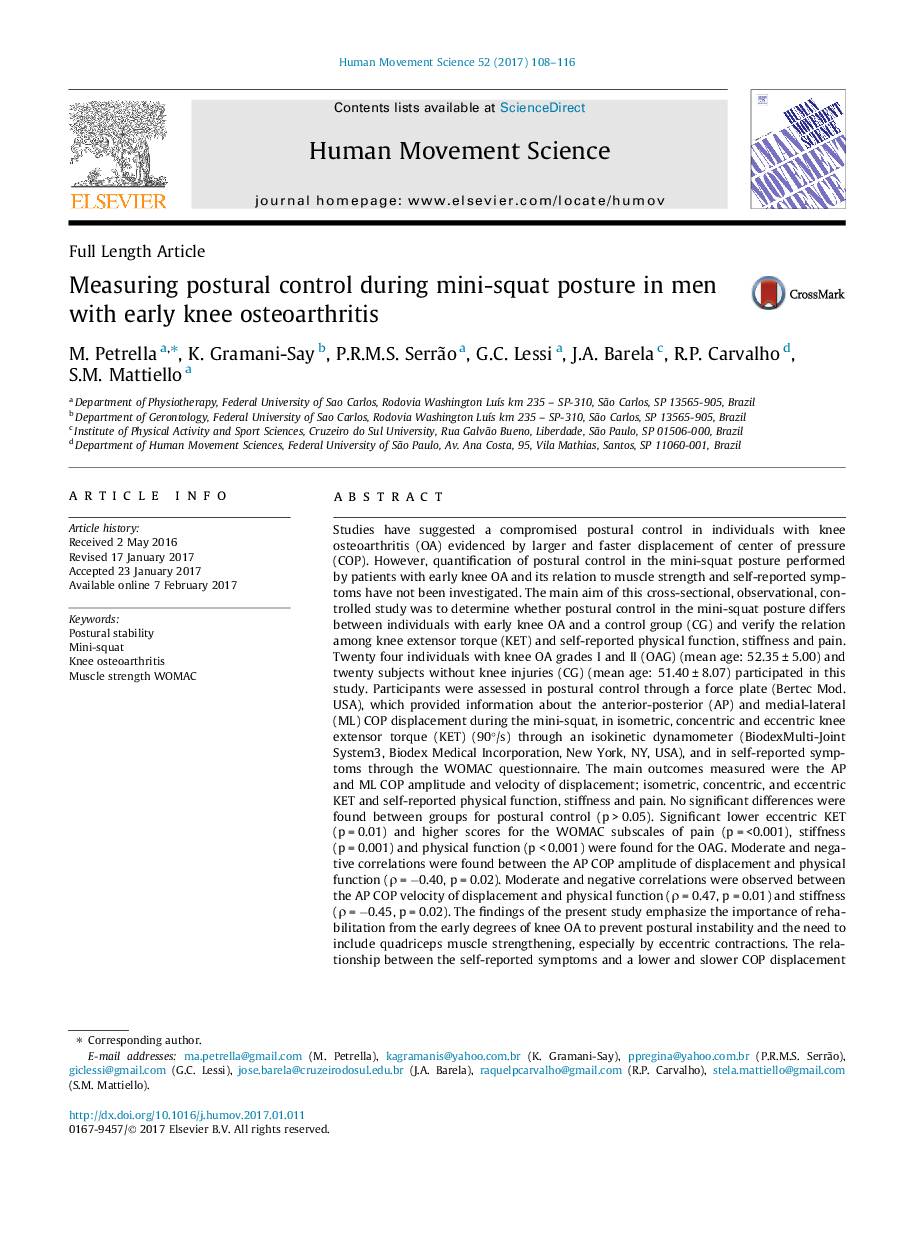| Article ID | Journal | Published Year | Pages | File Type |
|---|---|---|---|---|
| 5042060 | Human Movement Science | 2017 | 9 Pages |
â¢Stability in the mini-squat was studied in men with early knee osteoarthritis (KOA).â¢Correlation was done among postural stability and knee extensor torque and symptoms.â¢Early stages of KOA do not compromise postural control during the mini-squat.â¢Lower and slower displacement was related to higher dysfunction and stiffness.â¢Other postural strategies in men with KOA in the mini-squat was suggested.
Studies have suggested a compromised postural control in individuals with knee osteoarthritis (OA) evidenced by larger and faster displacement of center of pressure (COP). However, quantification of postural control in the mini-squat posture performed by patients with early knee OA and its relation to muscle strength and self-reported symptoms have not been investigated. The main aim of this cross-sectional, observational, controlled study was to determine whether postural control in the mini-squat posture differs between individuals with early knee OA and a control group (CG) and verify the relation among knee extensor torque (KET) and self-reported physical function, stiffness and pain. Twenty four individuals with knee OA grades I and II (OAG) (mean age: 52.35 ± 5.00) and twenty subjects without knee injuries (CG) (mean age: 51.40 ± 8.07) participated in this study. Participants were assessed in postural control through a force plate (Bertec Mod. USA), which provided information about the anterior-posterior (AP) and medial-lateral (ML) COP displacement during the mini-squat, in isometric, concentric and eccentric knee extensor torque (KET) (90°/s) through an isokinetic dynamometer (BiodexMulti-Joint System3, Biodex Medical Incorporation, New York, NY, USA), and in self-reported symptoms through the WOMAC questionnaire. The main outcomes measured were the AP and ML COP amplitude and velocity of displacement; isometric, concentric, and eccentric KET and self-reported physical function, stiffness and pain. No significant differences were found between groups for postural control (p > 0.05). Significant lower eccentric KET (p = 0.01) and higher scores for the WOMAC subscales of pain (p = <0.001), stiffness (p = 0.001) and physical function (p < 0.001) were found for the OAG. Moderate and negative correlations were found between the AP COP amplitude of displacement and physical function (Ï = â0.40, p = 0.02). Moderate and negative correlations were observed between the AP COP velocity of displacement and physical function (Ï = 0.47, p = 0.01) and stiffness (Ï = â0.45, p = 0.02). The findings of the present study emphasize the importance of rehabilitation from the early degrees of knee OA to prevent postural instability and the need to include quadriceps muscle strengthening, especially by eccentric contractions. The relationship between the self-reported symptoms and a lower and slower COP displacement suggest that the postural control strategy during tasks with a semi-flexed knee should be further investigated.
